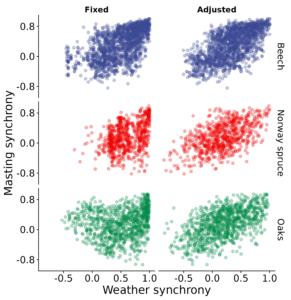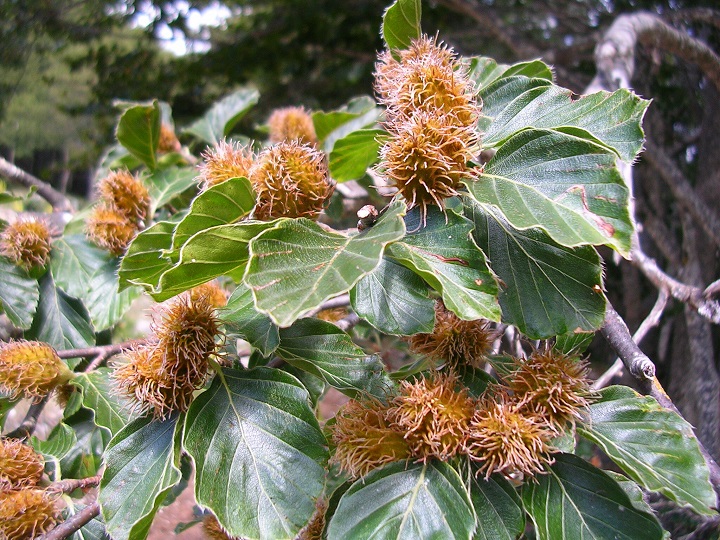Masting not only enhances plant reproductive efficiency and fitness but also influences entire food webs. However, quantifying the year-to-year variability in masting has been a subject of intense debate. The commonly used coefficient of variation falls short in accounting for the serial dependence and the presence of zeros in individual-level datasets, limiting its suitability for phenotypic selection, heritability, and climate change studies. To overcome these limitations, our three case studies introduce volatility and periodicity as novel metrics that capture both high and low-frequency variance, even in the presence of zeros. By examining multiple plant species, including Sorbus aucuparia, Pinus pinea, Quercus robur, Quercus pubescens, and Fagus sylvatica, we demonstrate how these new metrics greatly enhance ecological interpretations and pave the way for significant advancements in the analysis of long-term, individual-plant datasets.
New Phytologist: Mast-casting
Understanding the timing of masting is crucial for successful management and conservation efforts in ecosystems dominated by masting species. That’s why understanding the mechanisms behind masting and developing forecasting tools for seed production is urgently needed. In our recent New Phytologist paper we evaluated the predictive capabilities of three models—foreMast, ΔT, and a sequential model—in forecasting seed production in trees. By utilizing a comprehensive pan-European dataset of Fagus sylvatica seed production, we tested these model’s abilities to recreate past seed production dynamics, and identified dimensions that work well and gaps. One key finding from our study is the influence of high-quality data on prior seed production on the model’s predictive power. Incorporating good-quality data enhances models’ predictive power. This underscores the importance of implementing effective methods to monitor seed production, as they may serve as the foundation for developing accurate forecasting tools. While our models exhibit moderate success in predicting seed production dynamics, they are better at forecasting crop failures rather than bumper crops. The factors that reduce seed production are better understood compared to those responsible for large reproductive events. We acknowledge these challenges and present a roadmap to drive the discipline forward and encourage further advancements in mast forecasting.
Urszula Eichert defends her PhD thesis
dr Eichert, our irreplaceable lab manager, just defended her PhD on the behaviour of European hamster! Congratulations Ulka!
Global Change Biology: masting breakdown and tree size
Climate change continues to reshape our natural ecosystems, and its impact on tree populations is a topic of great concern. Our recent study investigating the response of European beech (Fagus sylvatica) to climate warming has uncovered intriguing insights into the complex relationship between tree reproduction, climate change, and forest dynamics.
The Masting Breakdown Phenomenon: One significant consequence of climate warming is the disruption of masting, the periodic synchronous production of large seed crops by trees. Masting breakdown occurs when warming reduces the synchrony and interannual variability of seed production, leading to a decline in viable seed production over time.
The Role of Tree Size: Our study further reveals that tree size plays a crucial role in mediating the effects of masting breakdown. While smaller trees experience increased seed predation over time, larger individuals suffer a disproportionate decrease in pollination efficiency. As a result, the ability of trees to produce viable seeds, declines across all size classes, with the greatest impact observed in large trees. This reversal of the correlation between tree size and viable seed production represents a potential for a significant shift in the dynamics of forest regeneration.
Implications for Forest Dynamics: The implications of these findings extend beyond individual trees to broader forest dynamics. The decline in viable seed production has consequences for the stand- and biogeographical-level processes of forest regeneration. Forests may struggle to maintain their populations if the declining seed production trend continues, leading to decreased resilience and potential shifts in species composition.
Management Strategies for Forest Resilience: Understanding the relationship between tree reproduction and climate change allows us to explore management options that can enhance forest resilience in the face of a warming climate. The study suggests that focusing on strategies to mitigate seed predation in small trees and improve pollination efficiency in larger trees could help counteract the adverse effects of masting breakdown. Implementing targeted interventions to support reproduction across all size classes may be crucial for safeguarding forest viability and maintaining the diversity of our ecosystems.
Conclusion: As climate change progresses, it is imperative to deepen our understanding of how trees respond to these environmental shifts. Our study on European beech offers valuable insights into the complex interplay between climate warming, tree reproduction, and forest dynamics. By recognizing the impact of masting breakdown and the role of tree size, we can develop effective management strategies to promote forest resilience in a changing world. Protecting our forests is not only crucial for the survival of tree populations but also essential for maintaining the countless benefits they provide to our planet and society.
Ecology Letters: masting regional synchrony
We are thrilled to announce the publication of our latest paper in Ecology Letters, which was primarily developed in the Forest Biology Center.
Masting is a fascinating natural phenomenon characterized by stunning, regional synchrony, with the Moran effect being responsible for reproduction in response to synchronized weather variations. However, species differ significantly in the degree of synchrony they exhibit, even when exposed to similar weather conditions. Why is this so?
Our research reveals that the spatiotemporal conservation of weather cues plays a critical role in driving this interspecific variation. If populations respond to a single cue simultaneously, they achieve synchrony. Conversely, if populations vary in the timing of the weather driver for seed production, synchrony cannot be attained.
Once we account for these phenological differences, weather becomes a reliable predictor of the scale of regional synchrony in both “highly” and “poorly” synchronized species. Take a look at how nicely the relationship between masting and weather synchrony aligns in oaks once we adjust for phenology!

GEB: reproduction of trees on a map of their form
We are excited to announce the publication of our latest paper in Global Ecology and Biogeography. We utilized an extensive dataset of seed production estimates in trees, which included approximately 800 species, to map seed production onto the tree form and function map.
This research was predominantly the result of Michał’s fellowship in France, where he worked with the LESSEM team on the MASTIF project at INRAE.
We invite you to explore our findings here: https://doi.org/10.1111/geb.13652. The cone picture is credited to Giorgio Vacchiano, a co-author of the paper.





